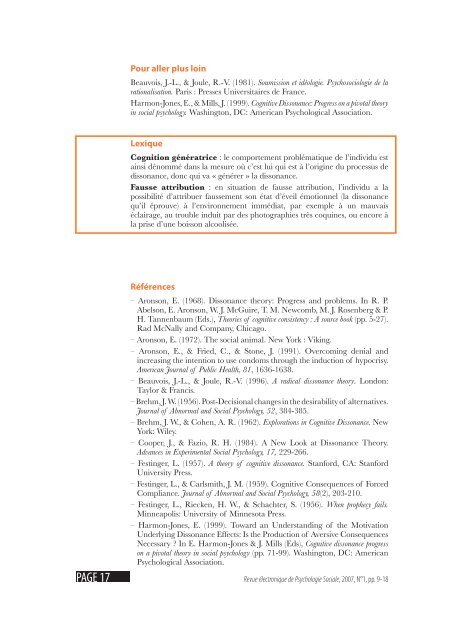Revue électronique de Psychologie Sociale
Revue électronique de Psychologie Sociale
Revue électronique de Psychologie Sociale
You also want an ePaper? Increase the reach of your titles
YUMPU automatically turns print PDFs into web optimized ePapers that Google loves.
PAGE 17<br />
Pour aller plus loin<br />
Beauvois, J.-L., & Joule, R.-V. (1981). Soumission et idéologie. Psychosociologie <strong>de</strong> la<br />
rationalisation. Paris : Presses Universitaires <strong>de</strong> France.<br />
Harmon-Jones, E., & Mills, J. (1999). Cognitive Dissonance: Progress on a pivotal theory<br />
in social psychology. Washington, DC: American Psychological Association.<br />
Lexique<br />
Cognition génératrice : le comportement problématique <strong>de</strong> l’individu est<br />
ainsi dénommé dans la mesure où c’est lui qui est à l’origine du processus <strong>de</strong><br />
dissonance, donc qui va « générer » la dissonance.<br />
Fausse attribution : en situation <strong>de</strong> fausse attribution, l’individu a la<br />
possibilité d’attribuer faussement son état d’éveil émotionnel (la dissonance<br />
qu’il éprouve) à l’environnement immédiat, par exemple à un mauvais<br />
éclairage, au trouble induit par <strong>de</strong>s photographies très coquines, ou encore à<br />
la prise d’une boisson alcoolisée.<br />
Références<br />
– Aronson, E. (1968). Dissonance theory: Progress and problems. In R. P.<br />
Abelson, E. Aronson, W. J. McGuire, T. M. Newcomb, M. J. Rosenberg & P.<br />
H. Tannenbaum (Eds.), Theories of cognitive consistency : A source book (pp. 5-27).<br />
Rad McNally and Company, Chicago.<br />
– Aronson, E. (1972). The social animal. New York : Viking.<br />
– Aronson, E., & Fried, C., & Stone, J. (1991). Overcoming <strong>de</strong>nial and<br />
increasing the intention to use condoms through the induction of hypocrisy.<br />
American Journal of Public Health, 81, 1636-1638.<br />
– Beauvois, J.-L., & Joule, R.-V. (1996). A radical dissonance theory. London:<br />
Taylor & Francis.<br />
– Brehm, J. W. (1956). Post-Decisional changes in the <strong>de</strong>sirability of alternatives.<br />
Journal of Abnormal and Social Psychology, 52, 384-385.<br />
– Brehm, J. W., & Cohen, A. R. (1962). Explorations in Cognitive Dissonance. New<br />
York: Wiley.<br />
– Cooper, J., & Fazio, R. H. (1984). A New Look at Dissonance Theory.<br />
Advances in Experimental Social Psychology, 17, 229-266.<br />
– Festinger, L. (1957). A theory of cognitive dissonance. Stanford, CA: Stanford<br />
University Press.<br />
– Festinger, L., & Carlsmith, J. M. (1959). Cognitive Consequences of Forced<br />
Compliance. Journal of Abnormal and Social Psychology, 58(2), 203-210.<br />
– Festinger, L., Riecken, H. W., & Schachter, S. (1956). When prophecy fails.<br />
Minneapolis: University of Minnesota Press.<br />
– Harmon-Jones, E. (1999). Toward an Un<strong>de</strong>rstanding of the Motivation<br />
Un<strong>de</strong>rlying Dissonance Effects: Is the Production of Aversive Consequences<br />
Necessary ? In E. Harmon-Jones & J. Mills (Eds), Cognitive dissonance progress<br />
on a pivotal theory in social psychology (pp. 71-99). Washington, DC: American<br />
Psychological Association.<br />
<strong>Revue</strong> <strong>électronique</strong> <strong>de</strong> <strong>Psychologie</strong> <strong>Sociale</strong>, 2007, N°1, pp. 9-18


